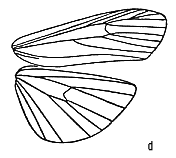|
The
scale of measurement given in description of new species is from the centre of
the thorax to the forewing apex. The scale on each genitalia photograph
represents 1mm.
Information
on habitat preference has been gained almost entirely from light trap surveys of
G. Kinabalu (Holloway, 1976), the G. Mulu National Park (Holloway, 1984a), from
collections made by Col. M.G. Allen, T.W. Harman and colleagues in Brunei and by
A.H. Kirk-Spriggs and Dr S.J. Willott in Sabah. Additional data on the fauna of
softwood plantations and material from the Forest Research Centre Collection,
Sepilok, have kindly been made available by Dr Chey Vun Khen of the Sabah Forest
Department (Chey, 1994). Broad vegetation categories were discussed in Part 4 of
this series.
Data
on geographical range are mainly from the collections of The Natural History
Museum (BMNH), but with some additional data on the Sumatran fauna that have
been made available through the collecting activities of Dr E. Diehl and other
members of the Heterocera Sumatrana Society. Data for Peninsular Malaysia are
supplemented from the collections of Mr H.S. Barlow and FRIM, the latter
particularly through recent surveys conducted by Dr J. Intachat.
A
few host-plant data are drawn from unpublished records of the International
Institute of Entomology. These are collated from material submitted to the
Institute for identification from throughout the Indo-Australian tropics. Of
particular note in recent years are records from material submitted by the
Indian Central Agricultural Research Institute Station in the Andaman Is. Plant
nomenclature follows Mabberley (1987).
Holotypes
of new taxa have been deposited in The Natural History Museum except where
indicated to the contrary.
Nomenclatural
details of all genus-group names are to be found in Watson, Fletcher & Nye
(1980), and are therefore not repeated here. These authors did not indicate
generic gender. Whilst the Code of Zoological Nomenclature stipulates that
adjectival species-group names should agree in gender with the genus-group name,
the application of this is fraught with difficulty (Holloway, 1993[4]). Given
modern requirements for computerised database construction, and given the
confusion that rectification would be likely to cause amongst users of
biosystematics not familiar with the niceties of the Latin language, all species
names given here have the orthography of the original description. The reader
should also note that the convention of putting author names in parentheses,
where the genus of combination is not the original one, has not been followed as
the situation is clear from the synonymy attached to each species treated.
The
classification by Hampson (1900) relied heavily on characters of wing venation.
Such characters appear generally to be of greater significance in the
Lithosiinae at generic level than in other moth groups, and many of the venation
drawings in Hampson are therefore reproduced here (Fig 1,
Fig 2, Fig 4, Fig
5, Fig 6, Fig 7, Fig
10) On the
other hand, his reliance primarily on such characters has led to many genera
being depositories for suites of unrelated taxa, a situation revealed
particularly when male and female genitalia are dissected. Where possible, such
genera have been revised and their taxa redistributed amongst more appropriate
genera. But in many cases this proved impossible, particularly for the genus Eilema
Hübner. Then the characteristics of the type species of the genus are
described, and inappropriately assigned species are retained within it with the
genus-group name in inverted commas. The taxonomic note for each will indicate
the manner in which these species differ significantly from the typical.
Efforts
have been made to examine all relevant type specimens. Most were in The Natural
History Museum but there are also significant holdings in the University Museum
Oxford (mostly material collected by Alfred Russel Wallace in Sarawak and
described by Francis Walker) and in the Nationaal Natuurhistorisch Museum
�Naturalis�, Leiden (types of Snellen, Heylaerts, van Eecke and Roepke).
The
Lithosiinae have a number of extremely species-rich genera in Borneo, and some
of those containing smaller sized moths proved to have over half their species
undescribed. Thus 2 of 17 Cyana Walker
and of 19 Barsine Walker, mostly large
in size, were new, whereas 9 of 18 Teulisna
Walker, 20 of 34 Eugoa Walker, 19
of 32 Lyclene Moore and as many as 12
(80%) of 15 Adites Moore required
description. 30% of the Bornean fauna is here described as new.
Adites,
Barsine and Lyclene are genera in the Nudariini that are considered here to be
the best depositories for the bulk of the Bornean taxa previously placed in Asura
Walker and Miltochrista Hübner as discussed. (see
Asura Walker).
Unassigned,
possibly plesiomorphic genera
The
six genera treated first are, for reasons given (see
Introduction), considered to be
plesiomorphic within the subfamily, but either lack the features used to
distinguish the tribe Lithosiini that follows, or these features (e.g. of early
stages) have yet to be investigated. The first three are part of a complex of
taxa that was included in the genus Agylla
Walker in the past (e.g. Hampson, 1900). The last three are part of a
complex of genera that share striking forewing patterns of blue-black on pale
dull yellow. The comments on Agylla larval
characters and adult resting posture in Bendib & Minet (1999) refer only to
this genus in its strict New World sense. The data on larvae of Old World taxa
do not give details of chaetotaxy, and their adult resting posture is ambiguous,
with it being involute in the blue-black and yellow complex and involute to
tectiform in many of the Old World �Agylla� complex. Only Vamuna
Moore holds the wings at rest in the manner considered apomorphic for the
Lithosiini by Bendib & Minet (1999), as discussed (see
Lithosiini). However, the
forewing facies of Hesudra species,
grey with a paler costal edge, is similar to that of many Lithosiini. Loss of
hindwing veins is rare (one lost in Chrysaeglia
Butler; Fig 1d).

Chrysaeglia
magnifica Walker
|

